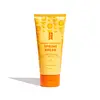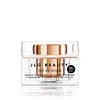What's inside
What's inside
 Key Ingredients
Key Ingredients

 Benefits
Benefits

 Concerns
Concerns

 Ingredients Side-by-side
Ingredients Side-by-side

Ethylhexyl Methoxycinnamate 6.9%
UV AbsorberEthylhexyl Salicylate 3%
UV AbsorberZinc Oxide 4%
Cosmetic ColorantWater
Skin ConditioningGlycerin
HumectantPropylene Glycol
HumectantIsopropyl Palmitate
EmollientCaprylic/Capric Triglyceride
MaskingCyclopentasiloxane
EmollientVp/Eicosene Copolymer
Cetearyl Alcohol
EmollientCeteareth-20
CleansingPhenoxyethanol
PreservativeHydroxyethyl Acrylate/Sodium Acryloyldimethyl Taurate Copolymer
Emulsion StabilisingCyclotetrasiloxane
EmollientSqualane
EmollientTocopheryl Acetate
AntioxidantPolysorbate 60
EmulsifyingDisodium EDTA
Triethoxycaprylylsilane
Camellia Oleifera Leaf Extract
AstringentChamomilla Recutita Flower Extract
MaskingCucumis Sativus Fruit Extract
EmollientVitis Vinifera Seed Extract
AntimicrobialGlycereth-2 Cocoate
EmulsifyingCitric Acid
BufferingSodium Hyaluronate
HumectantIodopropynyl Butylcarbamate
PreservativeEthylhexyl Methoxycinnamate 6.9%, Ethylhexyl Salicylate 3%, Zinc Oxide 4%, Water, Glycerin, Propylene Glycol, Isopropyl Palmitate, Caprylic/Capric Triglyceride, Cyclopentasiloxane, Vp/Eicosene Copolymer, Cetearyl Alcohol, Ceteareth-20, Phenoxyethanol, Hydroxyethyl Acrylate/Sodium Acryloyldimethyl Taurate Copolymer, Cyclotetrasiloxane, Squalane, Tocopheryl Acetate, Polysorbate 60, Disodium EDTA, Triethoxycaprylylsilane, Camellia Oleifera Leaf Extract, Chamomilla Recutita Flower Extract, Cucumis Sativus Fruit Extract, Vitis Vinifera Seed Extract, Glycereth-2 Cocoate, Citric Acid, Sodium Hyaluronate, Iodopropynyl Butylcarbamate
Homosalate 15%
Skin ConditioningEthylhexyl Salicylate 5%
UV AbsorberZinc Oxide 3%
Cosmetic ColorantWater
Skin ConditioningGlycerin
HumectantCaprylic/Capric Triglyceride
MaskingCetearyl Alcohol
EmollientGlyceryl Stearate
EmollientPEG-100 Stearate
Dimethicone
EmollientHydrolyzed Vegetable Protein
Skin ConditioningNelumbo Nucifera Flower Extract
Skin ConditioningWithania Somnifera Root Extract
Skin ConditioningHimanthalia Elongata Extract
Skin ProtectingGlycyrrhiza Glabra Root Extract
BleachingGigartina Stellata Extract
Skin ProtectingHydrogenated Lecithin
EmulsifyingChondrus Crispus Extract
Skin ConditioningCamellia Sinensis Leaf Extract
AntimicrobialAspalathus Linearis Extract
Skin ConditioningBoswellia Serrata Extract
Skin ConditioningHoney Extract
HumectantTocopheryl Acetate
AntioxidantTocopherol
AntioxidantEthyl Ferulate
AntioxidantTrehalose
HumectantDisodium EDTA
Cetyl Palmitate
EmollientBisabolol
MaskingTriethoxycaprylylsilane
Sorbitan Stearate
EmulsifyingPolysorbate 80
EmulsifyingButylene Glycol
HumectantSodium Hyaluronate
HumectantIsopentyldiol
HumectantPalmitoyl Tetrapeptide-10
Skin ConditioningFarnesol
PerfumingTetrapeptide-14
Skin ConditioningCaprylyl Glycol
EmollientHexylene Glycol
EmulsifyingEthylhexylglycerin
Skin ConditioningXanthan Gum
EmulsifyingCitric Acid
BufferingPhenoxyethanol
PreservativeSodium Benzoate
MaskingHomosalate 15%, Ethylhexyl Salicylate 5%, Zinc Oxide 3%, Water, Glycerin, Caprylic/Capric Triglyceride, Cetearyl Alcohol, Glyceryl Stearate, PEG-100 Stearate, Dimethicone, Hydrolyzed Vegetable Protein, Nelumbo Nucifera Flower Extract, Withania Somnifera Root Extract, Himanthalia Elongata Extract, Glycyrrhiza Glabra Root Extract, Gigartina Stellata Extract, Hydrogenated Lecithin, Chondrus Crispus Extract, Camellia Sinensis Leaf Extract, Aspalathus Linearis Extract, Boswellia Serrata Extract, Honey Extract, Tocopheryl Acetate, Tocopherol, Ethyl Ferulate, Trehalose, Disodium EDTA, Cetyl Palmitate, Bisabolol, Triethoxycaprylylsilane, Sorbitan Stearate, Polysorbate 80, Butylene Glycol, Sodium Hyaluronate, Isopentyldiol, Palmitoyl Tetrapeptide-10, Farnesol, Tetrapeptide-14, Caprylyl Glycol, Hexylene Glycol, Ethylhexylglycerin, Xanthan Gum, Citric Acid, Phenoxyethanol, Sodium Benzoate
Ingredients Explained
These ingredients are found in both products.
Ingredients higher up in an ingredient list are typically present in a larger amount.
This ingredient is an emollient, solvent, and texture enhancer. It is considered a skin-softener by helping the skin prevent moisture loss.
It helps thicken a product's formula and makes it easier to spread by dissolving clumping compounds.
Caprylic Triglyceride is made by combining glycerin with coconut oil, forming a clear liquid.
While there is an assumption Caprylic Triglyceride can clog pores due to it being derived from coconut oil, there is no research supporting this.
Learn more about Caprylic/Capric TriglycerideCetearyl alcohol is a mixture of two fatty alcohols: cetyl alcohol and stearyl alcohol. It is mainly used as an emulsifier. Emulsifiers help prevent the separation of oils and products. Due to its composition, it can also be used to thicken a product or help create foam.
Cetearyl alcohol is an emollient. Emollients help soothe and hydrate the skin by trapping moisture.
Studies show Cetearyl alcohol is non-toxic and non-irritating. The FDA allows products labeled "alcohol-free" to have fatty alcohols.
This ingredient is usually derived from plant oils such as palm, vegetable, or coconut oils. There is debate on whether this ingredient will cause acne.
Due to the fatty acid base, this ingredient may not be Malassezia folliculitis safe.
Learn more about Cetearyl AlcoholCitric Acid is an alpha hydroxy acid (AHA) naturally found in citrus fruits like oranges, lemons, and limes.
Like other AHAs, citric acid can exfoliate skin by breaking down the bonds that hold dead skin cells together. This helps reveal smoother and brighter skin underneath.
However, this exfoliating effect only happens at high concentrations (20%) which can be hard to find in cosmetic products.
Due to this, citric acid is usually included in small amounts as a pH adjuster. This helps keep products slightly more acidic and compatible with skin's natural pH.
In skincare formulas, citric acid can:
While it can provide some skin benefits, research shows lactic acid and glycolic acid are generally more effective and less irritating exfoliants.
Most citric acid used in skincare today is made by fermenting sugars (usually from molasses). This synthetic version is identical to the natural citrus form but easier to stabilize and use in formulations.
Read more about some other popular AHA's here:
Learn more about Citric AcidDisodium EDTA plays a role in making products more stable by aiding other preservatives.
It is a chelating agent, meaning it neutralizes metal ions that may be found in a product.
Disodium EDTA is a salt of edetic acid and is found to be safe in cosmetic ingredients.
Learn more about Disodium EDTAEthylhexyl Salicylate is an organic compound used to block UV rays. It primarily absorbs UVB rays but offers a small amount of UVA protection as well.
Commonly found in sunscreens, Ethylhexyl Salicylate is created from salicylic acid and 2-ethylhexanol. You might know salicylic acid as the effective acne fighter ingredient and BHA.
The ethylhexanol in this ingredient is a fatty alcohol and helps hydrate your skin, similar to oils. It is an emollient, which means it traps moisture into the skin.
According to manufacturers, Ethylhexyl Salicylate absorbs UV wavelength of 295-315 nm, with a peak absorption at 307-310 nm. UVA rays are linked to long term skin damage, such as hyperpigmentation. UVB rays emit more energy and are capable of damaging our DNA. UVB rays cause sunburn.
Learn more about Ethylhexyl SalicylateGlycerin is already naturally found in your skin. It helps moisturize and protect your skin.
A study from 2016 found glycerin to be more effective as a humectant than AHAs and hyaluronic acid.
As a humectant, it helps the skin stay hydrated by pulling moisture to your skin. The low molecular weight of glycerin allows it to pull moisture into the deeper layers of your skin.
Hydrated skin improves your skin barrier; Your skin barrier helps protect against irritants and bacteria.
Glycerin has also been found to have antimicrobial and antiviral properties. Due to these properties, glycerin is often used in wound and burn treatments.
In cosmetics, glycerin is usually derived from plants such as soybean or palm. However, it can also be sourced from animals, such as tallow or animal fat.
This ingredient is organic, colorless, odorless, and non-toxic.
Glycerin is the name for this ingredient in American English. British English uses Glycerol/Glycerine.
Learn more about GlycerinPhenoxyethanol is a preservative that has germicide, antimicrobial, and aromatic properties. Studies show that phenoxyethanol can prevent microbial growth. By itself, it has a scent that is similar to that of a rose.
It's often used in formulations along with Caprylyl Glycol to preserve the shelf life of products.
Sodium Hyaluronate is hyaluronic acid's salt form. It is commonly derived from the sodium salt of hyaluronic acid.
Like hyaluronic acid, it is great at holding water and acts as a humectant. This makes it a great skin hydrating ingredient.
Sodium Hyaluronate is naturally occurring in our bodies and is mostly found in eye fluid and joints.
These are some other common types of Hyaluronic Acid:
Learn more about Sodium HyaluronateTocopheryl Acetate is AKA Vitamin E. It is an antioxidant and protects your skin from free radicals. Free radicals damage the skin by breaking down collagen.
One study found using Tocopheryl Acetate with Vitamin C decreased the number of sunburned cells.
Tocopheryl Acetate is commonly found in both skincare and dietary supplements.
Learn more about Tocopheryl AcetateTriethoxycaprylylsilane is a silicone used to bind and stabilize ingredients.
As an emulsifier, it helps prevent ingredients from separating. This can help elongate the shelf life of products.
Triethoxycaprylylsilane is often used to coat mineral sunscreens ingredients to help give a better feel. It also helps reduce oxidative stress in sunscreens.
Learn more about TriethoxycaprylylsilaneWater. It's the most common cosmetic ingredient of all. You'll usually see it at the top of ingredient lists, meaning that it makes up the largest part of the product.
So why is it so popular? Water most often acts as a solvent - this means that it helps dissolve other ingredients into the formulation.
You'll also recognize water as that liquid we all need to stay alive. If you see this, drink a glass of water. Stay hydrated!
Learn more about WaterZinc Oxide is a mineral broad-spectrum UV filter; it is the broadest UVA and UVB reflector approved by the FDA. It also has skin protectant and skin soothing properties.
Zinc oxide is one of the most effective broad-spectrum UV filters. It protects against UVB, UVAII, and UVAI. In comparison to its counterpart titanium dioxide, zinc oxide provides uniform and extended UVA protection.
Another great benefit? This ingredient is highly photostable so it won't degrade easily under sunlight.
A common myth is that mineral UV filters are widely believed to primarily reflect UV light.
However, modern research shows titanium dioxide absorbs UV radiation like chemical filters (~95% absorption & 5% reflection).
Zinc oxide has great skin soothing properties so you'll likely find this in sunscreens formulated for sensitive skin or babies/children. It is unlikely to cause "eye sting" like other sunscreen ingredients.
Regulatory agencies consider zinc oxide to be non-toxic and safe. It has also been shown to not penetrate the skin.
Unfortunately, this ingredient does leave a visible white cast. This is why mineral sunscreens are often less cosmetically elegant than chemical or hybrid ones.
In cosmetics, zinc oxide can be found in both non-nano and nano-sized forms. The nano version is used to reduce white cast and improve the texture of sunscreen formulas.
There are ongoing concerns surrounding nano-zinc oxide's impact on marine ecosystems and whether it can be absorbed into skin.
Regarding marine ecosystems and coral reefs, there is no conclusive evidence that any form of zinc oxide (or any other sunscreen ingredients) will cause harm. The science is still developing but many consumers are keeping a close eye on this issue.
Please note, many destinations have reef-safety sunscreen rules. For instance, the U.S. Virgin Islands advises all visitors to use non-nano mineral sunscreens.
There has also been some stir about whether micronized or nano zinc oxide has potential photoxicity and absorption through the skin/lungs.
An in-vitro (done in a test tube or petri dish) study demonstrated micronized zinc oxide to have potential phototoxicity. There's no need to fret; the EU Commission's Scientific Committee on Consumer Safety has stated, "The relevance of these findings needs to be clarified by appropriate investigations in vivo." Or in other words, further studies done on living organisms are needed to prove this.
Current research shows zinc oxide nanoparticles do not penetrate intact or sunburned skin. They either remain on the surface or in the outermost layer of dead skin (stratum corneum).
Zinc oxide is one of only two classified mineral UV filters with titanium dioxide being the other one.
Fun fact: Zinc has been used throughout history as an ingredient in paint and medicine. An Indian text from 500BC is believed to list zinc oxide as a salve for open wound. The Ancient Greek physician Dioscorides has also mentioned the use of zinc as an ointment in 1AD.
Learn more about Zinc Oxide